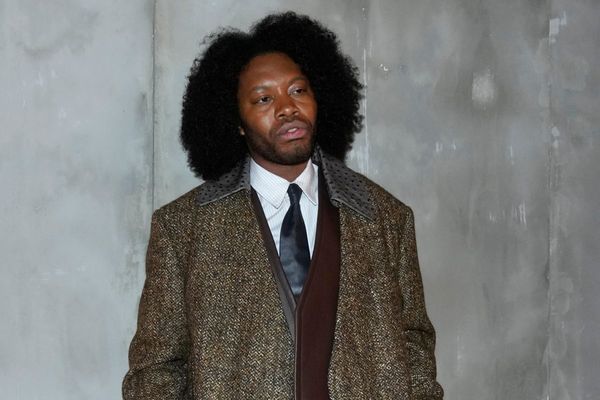There are some moments in time that are so incredible that they're almost unbelievable. The "receipts or it didn't happen" things.
Like a man born with three legs, four feet and 16 fingers who worked as a circus performer by day and built a relatively "normal" life with his wife and four kids. Or how a guide dog saved her owner's life by leading him down 78 flights of stairs in the World Trade Center before they collapsed on the morning of the 9/11 attacks.
Facebook pages Old Historical Pictures and Old Photo Archive share such "receipts" of fascinating stories from years gone by. The unique and rare vintage photos include some surprising facts about famous folk, as well as extraordinary tales of ordinary people.
Bored Panda has put together a compilation of the best. Keep scrolling as you take a peek behind the curtain of history and don't forget to upvote your favorites.
#1
At 18, Elizabeth Cochrane lived in Pittsburgh when she read an article titled What Are Girls Good For, which claimed their only purpose was to have children and manage the home. Outraged, she wrote an anonymous rebuttal that impressed the local newspaper editor so much that he hired her.
Following the custom of the time, he gave her a pen name taken from a Stephen Foster song: Nellie Bly. Passionate about investigative journalism, Bly was assigned to "women’s topics" like fashion and society.
However, after exposing the harsh conditions of factory workers, she traveled to Mexico at just 21 to report on the working-class population. Her writings got her into trouble with the authorities, forcing her to flee.
At 23, she was hired by Joseph Pulitzer’s New York World and undertook the investigation that made her famous: she posed as a patient in the Women’s Lunatic Asylum in New York. Her shocking report led to reforms in the treatment of the mentally ill.
In 1889, inspired by Around the World in 80 Days, she embarked on a solo journey around the globe. Her return after 72 days set a record and made her an international celebrity. At 31, she married industrialist Robert Seaman and left journalism, helping run his business and patenting two inventions.
During World War I, she returned to reporting, becoming one of the first women to cover an active war zone. She passed away on January 27, 1922, at the age of 57, leaving behind a groundbreaking legacy in journalism.

Image credits: 90's Life
If history classes were as fascinating as the stories on this list, I might have paid a lot more attention. Sometimes it's not the famous historical figures who hold the most interesting stories. But rather the ordinary people who never made it into the text books.
Take Francesco (Frank) Lentini for example. Born in 1889, with three legs, a fourth foot extending from his knee, sixteen fingers and two nether regions. His rare condition developed while he was in the womb. Lentini had a parasitic twin connected at the bottom of his spine. As time passed, he became the dominant twin, and the other one stopped developing.
The baby's parents wanted his extra leg amputated but surgeons weren't willing to carry out the procedure at the risk of his life. He grew up being taunted and bullied because of his appearance, and earned the nickname "the little monster."
#2
Biracial Family taken circa 1900, Tennessee, USA. He was Jim Turner, from an affluent white family in Henning, TN, and his wife Carrie Turner, a schoolteacher. Their sons George, William, and Hardin, who became a doctor. This is a stunning portrait of a family who defied societal norms and embraced their mixed heritage with pride, showcasing that love knows no boundaries.

Image credits: Old Past Days
#3
The last American slave ship docked illegally in Mobile, Alabama in 1860, carrying about 160 West African captives. Among them was Cudjo Lewis, who recognized how his birth culture might be erased while toiling in this new land. So when he was freed, he purchased two acres and started a self-sufficient community of survivors of the last slave ship. Known to outsiders as Africatown, Lewis' neighborhood was modeled on his West African home, where extended families lived together, members conversed in their regional languages, and partook in traditions that might otherwise be lost to them in America. Today, Africatown still exists and houses the descendants of the nation's last slave ship community.

Image credits: OldPhotoArchive
But Lentini would go on to overcome his challenges and make history. In 1898 he traveled to America, and within a year, people were paying money to see him perform at the circus.
Instead of the "little monster," the Italian was billed as "The Three-Legged Sicilian," "The Greatest Medical Wonder of All Time, "The Great Lentini," and "The Only Three-Legged Football Player in the World," reports History Expose.
Lentini's talents, and extra leg, earned him celebrity status and a lot of money. He got married, had four kids, got divorced, got married for a second time and lived life to the fullest. He sadly died of lung failure in 1966, at the age of 77.
#4
In January 1925, a diphtheria epidemic tore through Nome, Alaska. The closest medication was over 500 miles away — and the only way to transport it was by dog sled. More than 20 mushers volunteered to set up a relay to quickly move the antitoxin serum to Nome through brutal winter conditions in temperatures of 30 degrees below zero. Though a dog called Togo completed the longest and most dangerous part of the route, it was a husky named Balto who led the final team of dogs into Nome with the life-saving medicine and became a national hero.

Image credits: OldPhotoArchive
#5
7 Oct 1943, Ottla Kafka, beloved sister of author Franz Kafka, was gassed on arrival at Auschwitz after volunteering to escort a group of orphans from the Terezin ghetto so they wouldn’t be afraid.

Image credits: History Time
#6
For over 15 years after his father Bob Ross died in 1995, Steve Ross couldn't bring himself to stand in front of an easel, let alone teach his painting classes. But now, the son of the famed "happy trees" painter has picked up his brush again — and he's teaching the Bob Ross technique in various states.

Image credits: OldPhotoArchive
It's not only human beings who go down in history for their heroic acts. The name Roselle deserves a special mention. The yellow labrador was taking a nap under her owner's desk one morning when she woke to the building shuddering. People were shouting and chaos ensued but the dog calmly got up and did what she was trained to do.
She led her blind owner Michael Hingson from his 78th-floor office down dozens of flights of stairs until they reached the bottom. "It wasn’t until they were outside that the group realized the extent of the damage caused to the World Trade Center during the 9/11 attacks," reports All That's Interesting.
With people running and screaming, Roselle led Hingson through the crowds and to a subway station. Just ten minutes later, the North Tower collapsed.
#7
A sharecropper mother from Transylvania, Louisiana, educates her children at home, focusing on letters and numbers. (1937)

Image credits: 90's Life
#8
A child with polio learning to walk inside parallel bars (around the time physical therapy was born).
Polio causes paralysis in approximately one out of every 200 cases. Survivors like this two-year-old child, often underwent months or even years of physical therapy to regain mobility.
Polio Rehabilitation Center Sudbury General Hospital, Canada, 1953.

Image credits: Marvelous History
#9
The day after she graduated high school in 1964, Dolly Parton left her home in Tennessee's Great Smoky Mountains and boarded the first bus to Nashville with a suitcase made of cardboard — and filled with songs. She quickly impressed Nashville's country music moguls with her compositions, but they insisted that her voice just wouldn't make her a star.

Image credits: OldPhotoArchive
Roselle received an award from the American Kennel Club in 2002 in honor of “canine excellence” among service dogs.
"Two years later, a veterinarian diagnosed Roselle with immune-mediated thrombocytopenia, a disease that affects blood platelets," reports the All That's Interesting. "Hingson believes the toxic air conditions that she faced helping him escape on 9/11 caused her condition."
Roselle lived another seven more years before she crossed the rainbow bridge on June 26, 2011, with Hingson by her side.
#10
Cop stops the traffic so a mother cat holding a kitten can cross safely. According to the book "Great News Photos and the Stories Behind Them", photographer Harry Warnecke missed the original crossing but convinced the cop to reenact it three times - to the consternation of irate motorists - until he got the shot just right. It was the craziest thing that happened that year. New York, 1925.

Image credits: Old Past Days
#11
On January 27, 1945, Soviet scouts in southern Poland stumbled upon what appeared to be an abandoned N*zi camp near the town of Oświęcim. They had no idea that the camp even existed and were stunned to see thousands of emaciated and brutalized prisoners, some barely clinging to life, staring at them through the barbed-wire fence.

Image credits: OldPhotoArchive
#12
A young Carrie Fisher watches her mother Debbie Reynolds perform on stage. (1963)

Image credits: 90's Life
#13
In January 1965, an Alabama woman named Annie Lee Cooper lined up at her county courthouse to vote. This was not her first attempt, as she had been turned away from the polls just two years earlier. And after failing the impossible literacy tests made to keep Black people from the ballot box, Cooper decided that this time would be different. When a notoriously racist cop named Jim Clark began to demand that she abandon her spot in line, Cooper did her best to ignore him. But when he poked her in the neck with his billy club, Cooper took action — and punched him square in the face.

Image credits: OldPhotoArchive
#14
In 1871, Anna Swan married Martin Van Buren Bates in London. It was an eye-catching wedding — as both the bride and the groom stood almost 8 feet tall and, in fact, the bride was a bit taller.

Image credits: OldPhotoArchive
#15
Soba noodles deliveryman in Tokyo, Japan. 1935. Photo by the Mainichi Shimbun.

Image credits: History Time
#16
Street urchin found by Thomas Barnardo in Whitechapel that led to his orphanage and later a ragged school to educate the East destitute!

Image credits: 90's Life
#17
“Of course, we tried to keep in mind how hard it was for the child. She was hungering for the world outside, for life with other children, and when my wife came up, Anne would greet her with an almost unpleasant curiosity. She would ask about /.../ our daughter. She wanted to know what [she] was doing, what boyfriends she had, what was happening at the hockey club, whether [she] had fallen in love. And as she asked she would stand there, thin, in her washed out clothes, her face snow-white, for they all had not been out of doors for so long. My wife would always bring her something, a pair of sandals or a piece of cloth; but coupons were so scarce and we did not have enough money to buy on the black market.”
(Johannes Kleiman) Photo: Anne (right) with her friend Sanne Ledermann, around 1935.

Image credits: History Time
#18
In 1938, Bertha Hill, a coal miner's daughter from West Virginia, was captured doing the family’s laundry — a task that required strength, perseverance, and hard work. The laundry wasn’t done with the convenience of running water, as the family had to carry water uphill from a nearby spring to wash their clothes. This photo, taken by M.P. Wolcott, highlights not only the daily hardships faced by coal miner families but also the resourcefulness and dedication required to make life work in the mountains. For Bertha and others like her, even routine chores demanded significant physical effort, yet these tasks were often done with little complaint, as they were essential for keeping the family going. The image is a poignant reminder of the resilience of coal miner families in rural Appalachia during the Great Depression.

Image credits: 90's Life
#19
Children going to school having to cross a river by pulley, Modena, Italy, 1959

Image credits: Porodicnostablo
#20
Born on Dec. 4, 1961, Rocky Dennis had a rare disease known as craniodiaphyseal dysplasia that contorted the bones in his face. His life became the inspiration for the 1985 film Mask. Doctors predicted that Dennis would die by the age of seven.

Image credits: OldPhotoArchive
#21
Before Barbie's official debut in 1959, most young girls were given baby dolls as toys, meaning that they often found themselves playing the role of a mother or a caregiver. But since Barbie looked like an adult woman, it allowed girls to imagine a variety of different futures and careers for themselves, ranging from cheerleaders to doctors to astronauts. While much has been said about this iconic doll, not everyone knows about its creator, Ruth Handler.

Image credits: OldPhotoArchive
#22
The last known photograph of Tsar Nicholas II, on the grounds of his royal residence, 1917.

Image credits: History Time
#23
27 January 1945 | On Saturday, at around 9 a.m. the first Soviet soldier from a reconnaissance unit of the 100th Infantry Division appeared on the grounds of the prisoners' infirmary in Monowitz. The entire division arrived half an hour later. The same day a military doctor arrived and began to organize assistance. In the afternoon soldiers of the Red Army entered the vicinity of the Auschwitz main camp and Birkenau. Near the main camp, they met resistance from retreating German units. 231 Red Army soldiers died in close combat for the liberation of Auschwitz, Birkenau and Monowitz.
Two of them died in front of the gates of Auschwitz main camp. One of them was Lieutenant Gilmudin Badryjewicz Baszirow. The first Red Army troops arrived in Birkenau and Auschwitz at around 3 p.m. and were joyfully greeted by the liberated prisoners. After the removal of mines from the surrounding area, soldiers of the 60th Army of the 1st Ukrainian Front marched into the camp and brought freedom to the prisoners who were still alive. On the grounds of the main camp were 48 corpses and in Birkenau over 600 corpses of male and female prisoners who were shot or died in the last few days.
At the time of the Red Army's arrival, there were 7,000 sick and exhausted prisoners in the Auschwitz, Birkenau and Monowitz camps. Read about the final days of the operation of the German N*zi camp Auschwitz, the tragedy of evacuation, the moment of liberation by the Soviet Army on 27 January 1945 & fate of some 7,500 liberated prisoners in our online lesson full of accounts of Survivors.

Image credits: 90's Life
#24
When Calvin Graham was 11 years old, he began shaving, convinced it would make him look older than he was. He also practiced speaking in a deep voice, pretending to talk like a man. Two years later, he forged his mom's signature to enlist in the U.S. Navy and ended up being awarded both the Bronze Star and Purple Heart before he turned 14.

Image credits: OldPhotoArchive
#25
Annie Edson Taylor poses with her cat and the barrel she successfully rode over Niagara Falls in 1901.

Image credits: 90's Life
#26
Margot is a pretty young lady. She dresses well and wears fashionable glasses. Margot is also athletic. She plays tennis, likes to skate and rowing with her classmates. She is a member of the “society for the promotion of water sports among young people” and win first price in a rowing match in Zaandam, together with her three teammates. She is also a member of a tennis club. In 1941 Jews were forbidden to be members of tennis clubs. Margot is also forbidden to take part in the rowing matches. Her teammates shows solidarity and refuses to take part, too. Photo: Margot (wearing sunglasses) with her classmates on a tennis court during the summer of 1940.

Image credits: History Time
#27
12-year-old Addie Laird working at a cotton mill in Vermont, 1910.

Image credits: History Time
#28
Finnish personnel disarm a floating sea mine from a small wooden rowboat in the Gulf of Finland near Haapasaari, Autumn 1944. Photo by SA-Kuva.

Image credits: 90's Life
#29
The head of the Statue of Liberty on display in Paris during the World's Fair in 1878. Seven years later, the entire statue would be disassembled and shipped to New York.

Image credits: OldPhotoArchive
#30
Born with three legs, four feet, 16 fingers, and two p**ises, Frank Lentini was a sight to behold, even among circus performers. One of the most famous sideshow attractions of the late Victorian era, Lentini eventually amassed a small fortune while building a relatively "normal" life with his wife and four children.

Image credits: OldPhotoArchive
#31
When Jim Carrey was 12, his father lost his job as an accountant. The family became homeless and lived out of a Volkswagen van that was too small for everyone, so Carrey and his brother slept in a tent outside. When his father finally did find work again, it was at a tire factory, and just to make ends meet, Carrey and his brother had to work there too, doing odd jobs as janitors and security guards for eight-hour shifts after a full day of school. Eventually, he dropped out at age 16 and never returned.

Image credits: OldPhotoArchive
#32
Schools out! Bucoda, WA, 1942. Photo by Arthur Rothstein.

Image credits: Quick_Presentation11
#33
An elderly resident of Berlin sits among the ruins, Berlin. Germany, 1945.

Image credits: Old Past Days
#34
Motorcycle police in the 1920's.

Image credits: History Timelines
#35
When it was 10 cents to call someone. NYC in the 1980's.

Image credits: History Time
#36
They don’t make ladies' hats like they used to!

Image credits: OldPhotoArchive
#37
Rosemary Kennedy was unlike her siblings, and after a convent failed to control her "urges" when she was in her early 20s, Joseph Kennedy had his eldest daughter lobotomized and institutionalized. What was once a bubbly woman who wanted to be a kindergarten teacher was turned into a barely functional individual who could only shriek and grunt.

Image credits: OldPhotoArchive
#38
Kids playing marbles in Missouri. (1940s)

Image credits: 90's Life
#39
These coal miners are buying groceries in the company store, still covered in coal dust. This company store was in Pursglove, West Virginia.

Image credits: History Time
#40
Emily Dickinson decided to withdraw from society and live a life of near-total seclusion in her family's home in Amherst, Massachusetts. While the exact reasons for her reclusiveness remain a mystery, this choice became a defining feature of her life and legacy. In her late twenties, Dickinson began to retreat from public life, rarely leaving her home and communicating with the outside world primarily through letters. Despite her physical isolation, she maintained rich and meaningful correspondences with friends, family, and literary figures, including Thomas Wentworth Higginson, a prominent editor and abolitionist. Their letters reveal a deep intellectual connection, with Dickinson often sharing her poetry and thoughts on life, nature, and art. One particularly fascinating event during this period was Dickinson's "white dress" phase.
Around the early 1860s, she began wearing only white clothing, a choice that has sparked much speculation among scholars. Some believe it symbolized her purity, her identity as a poet, or even her desire to separate herself from societal norms. This eccentric habit added to her mystique and contributed to her reputation as the "Belle of Amherst," a figure both enigmatic and captivating. Despite her seclusion, Dickinson's creative output during this time was extraordinary. She wrote nearly 1,800 poems, many of which explored themes of death, immortality, nature, and the human soul. Her decision to live a life of solitude allowed her to focus intensely on her craft, resulting in some of the most innovative and enduring poetry in American literature. Emily Dickinson's withdrawal from society and her dedication to her art make her one of history's most fascinating literary figures. Her life reminds us that creativity often thrives in the quietest corners, away from the noise of the world.

Image credits: 90's Life
#41
Unexploded parachute mine, Liverpool November 1940

Image credits: Amazing History
#42
A hotdog stand in New York. 1963)

Image credits: 90's Life
#43
An unidentified young man standing in front of Koreshan Unity general store on the Estero River, Florida c.1890-1910

Image credits: History Time
#44
Teenagers Cramming into a VW Beetle, 1964

Image credits: vintag.es
#45
The great-grandson of John D. Rockefeller, aspiring explorer and ethnographer Michael Rockefeller had no interest in managing his family's empire upon graduating from Harvard in 1960. Instead, he set out for the remote wilds of Dutch New Guinea to collect art made by the largely uncontacted Asmat people. But before he could reach the Asmat, Rockefeller's boat capsized and he was forced to attempt an arduous swim to shore. Despite a gargantuan search effort and a media firestorm, Rockefeller was never found and the authorities eventually declared him dead due to drowning in 1964.

Image credits: OldPhotoArchive
#46
A man named Earl Tupper invented Tupperware in the 1940’s, but the American public simply didn’t like plastic. The Company nearly went under until it took a cue from its leading seller, a woman named Brownie Wise in Miami, Florida. Ms. Wise and her mother had pioneered the idea of Patio Parties, which quickly caught on and became the now-famous Tupperware parties.

Image credits: OldPhotoArchive
#47
Worm vending machine. (1957)

Image credits: 90's Life
#48
The Noonans take a drive in their car with their 14 Children, 1920s.

Image credits: Tides of Tempus
#49
Testing football helmets, 1912.

Image credits: Old Past Days
#50
Home economics was one of those classes that gets a bad rap today, but which was really useful back in the day. Young ladies in those days were expected to understand homemaking and skills like pattern cutting, sewing, and home decor were likely to be used often once she married and had a family. While some never quite got the hang of it, many girls were practically sewing masters by the time they graduated high school, thanks to what they learned both at home and in home ec classes. Many home ec classes that followed in the 1980s onward didn’t even teach sewing and those that did focused on small projects that didn’t require much time, patience, or skill.

Image credits: OldPhotoArchive







